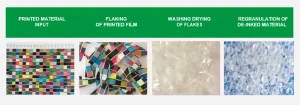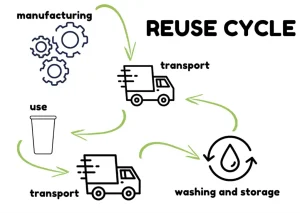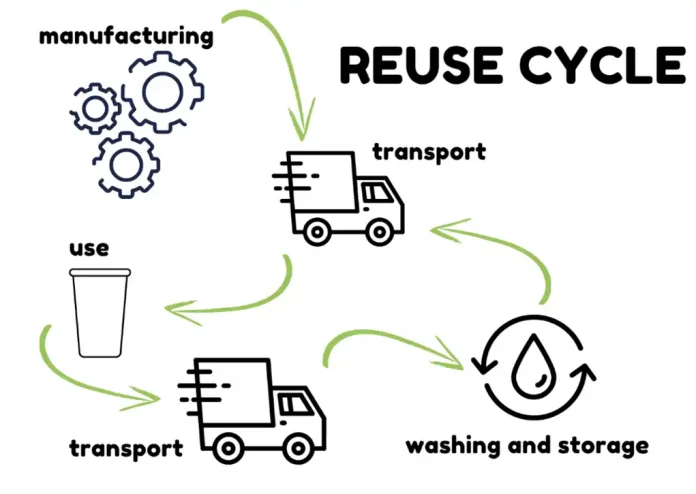By Carla Brown, Manager, Corporate Communications – Circular Economy Specialist, Siegwerk Druckfarben AG & Co.
A note from RadTech:
What does UV/EB sustainability mean to you? We thought this was an easy question, as our technology offers many circular economy benefits. Some benefits are true by definition; for example, no hazardous air pollutant materials (HAPs) are added to UV/EB formulations, so no HAPS are emitted; no solvents; and little to no VOCs. Other claims, such as recyclability, have been verified by individual suppliers and even other end-user groups (for example, American Forest & Paper Association’s (AF&PA) “UV/EB Cured Products Rated as “Easier to Recycle”). But, there still is much work to do as we “prove out” and document our technology. The RadTech Sustainability Committee is embarking on our group’s sustainability journey – and we invite you to contact Cara Bommarito (cara@radtech.org) to join us. We welcome your views, and thank Carla Brown at Siegwerk Druckfarben AG & Co. for sharing her work in a series of modules UV+EB Technology will publish throughout the year. Also, prepare to contribute as we develop a sustainability wiki.
Sustainability, an Introduction
Packaging is an integral part of our daily life. It preserves filled goods, provides information, helps to sell products by making packaging more attractive and much more. However, awareness is growing that despite all the positive features of packaging, it may impact our environment negatively when it leaks into nature. As a result, the importance of recyclable and reusable packaging, as well as a reduction in packaging overall, has been pushed to the forefront of business and consumer consciousness.
Packaging is considered in its entirety and also per individual component. In this regard, we see more and more efforts to reduce the environmental impacts of specific packaging components. For example, inks and coatings can contain volatile organic compounds (VOCs) and air pollutants (HAPs), in particular, for solvent-based printing. It generally is understood that UV/EB inks can be an attractive alternative to reduce emissions as they do not contain solvents. An additional aspect currently being looked at regarding the sustainability of packaging is the energy consumption during production.
As a leading global ink supplier for packaging applications and labels, Siegwerk strongly believes it is time to transfer packaging from a linear to a circular model that decouples economic growth from using finite resources and targets zero waste, allowing for wellbeing while respecting the natural boundaries of our planet. This is not only about improving existing packaging solutions but to really transfer packaging to a new way of management that limits the amount of resources entering the system and maximizes their utilization along the value chain; thereby, stopping the generation of waste.
Here, inks and coatings can play an important enabling role for the realization of circular packaging solutions. Their technical functionalities support the (re-)design of packaging following the three levers of a Circular Economy – Reduce, Reuse and Recycle – helping to keep materials in the loop.
In our opinion, sustainability does not only relate to these three levers but also to product and consumer safety. Ink must not have any negative impact on human beings – not during the production of the packaging, nor to the end consumer. We see an increasing number of regulations about what is to be and must not be used in inks for packaging – in particular, food packaging. Energy-cured inks are, by nature, highly reactive systems. On one hand, this leads to superior properties of the printed packaging. On the other hand, it creates some concerns when using energy-cured materials for food packaging.
New innovations now are available to meet (and even exceed) product safety standards, and additionally these may be utilized to increase recyclability or reduce the need for plastic use and other non-renewable raw materials, enabling the development of innovative sustainable and circular packaging solutions.
This article series will outline these issues and how they can be addressed in four modules:
- An Approach to Sustainability
- Biorenewable and Biodegradable
- Inks for Food Packaging
- Migration, Testing and Regulations
Module 1: An Approach to Sustainability
What does a sustainable packaging structure look like? It is packaging that either can be reused, recycled, composted or fulfills its function with minimal material usage – and of course, ideally, the packaging does not exist at all. Think about primary and secondary packaging. Do we always need two layers of packaging? In this lesson, we take a closer look at the three primary levers of the Circular Economy: Reuse, reduce and recycle.
Design for less (D4L) covers both packaging reuse (which requires packaging to be designed for reuse so that less packaging is produced) and reduction, with the aim to reduce the amount of packaging used within each item of packaging. This approach will be covered in more detail later in this discussion.
Design for recycling (D4R) is a design principle addressing the recyclability of packaging which promotes end-of-life considerations at an early life cycle stage (preferably at the design stage when materials are selected). D4R also must account for the infrastructure available to facilitate the collection and sorting of packaging, as this varies from country to country.
More About Design for Recycling

Today, recycling often actually means downcycling. A packaging structure is recycled and used in the material of, for example, a park bench. For a truly circular economy, however, packaging must be recycled so that the same type of packaging can be formed out of the

recycled material. A major challenge is to create safe and appealing food packaging from recycled packaging materials that stems from food packaging. Concerns related to this challenge include:
- Chemical contaminants in plastic may remain in the recycled material and migrate into the food;
- Microbial contamination; and
- Structural integrity of the recycled plastic.
While those challenges persist, inks and coatings play and will continue to play a vital role in enabling the effective recycling of packaging and a truly circular packaging life cycle.
Example 1: Recyclable mono-plastic packaging
Lamination is the process of combining two or more substrates to form a tough packaging structure to hold and provide barrier protection for the contents. However, multi-layer, multi-material packaging is challenging to recycle. The solution: Surface printing.
Lamination inks typically are sealed inside the lamination structure so that the ink surface is not exposed to the outside. Switching to surface printing enables an easy transition to a mono-material packaging structure, which is easier to recycle. This switch requires that the inks be resistant to external elements, such as water, solvents, detergents and other materials that may come into contact with the printed surface. The surface print often is accompanied by a coating to ensure that the packaging still performs as expected in terms of optics, scratch and temperature resistance.
UV/EB inks have a distinct advantage here as their formulation makes them intrinsically more resistant and, therefore, able to perform optimally in a surface-printed packaging structure. In this way, UV/EB inks play an important role in enabling the ultimate recyclability of packaging.

Example 2: Deinking and delamination
Even when packaging is recycled, the quality of current recycled materials typically still is poor. This is due to the unpleasant visual appearance or odor of different types of material after extrusion, which can be related to contaminants and the degradation of any remaining ink during the extrusion process of recycling. Unfortunately, this results in downcycling, as mentioned previously. The solution: Deinking and delamination primer.
A deinking and delamination primer creates a printable layer sensitive to an industrial washing process, allowing inks and coatings to be removed quickly and effectively. When laminated layers are separated, the end result may be clean, separated plastic layers.
Since such solutions separate wanted from unwanted material, the resulting high-quality recyclates can be used in new packaging materials.
A few considerations about deinking: Most ink chemistries can be deinked to a certain extent under the hot washing conditions the recycling industry uses today. However, the ideal scenario to improve sustainability is to fully deink under moderate washing conditions to render high-quality recyclate at minimal energy consumption. In this regard, the usage of a deinking primer often is the preferred option. It creates a robust system that allows the use of any kind of standard ink and will render high-quality recyclates.
More About Design 4 Less
When creating sustainable packaging, it’s important to ask whether the same results could be achieved with less packaging material. Can substitutions be made to reduce the amount of packaging needed? Can a product sold in bulk be packaged in bulk? For example, is there truly a need for individually packaged candy inside a larger candy bag?
However, due to the functions of packaging, including barriers to maintain hygiene or product freshness, reducing the amount of packaging may not be a simple task. Inks and coatings can play a vital role. Functional coatings, for instance, may replicate the functionalities of a packaging layer, thereby eliminating the need for an additional layer. A Design 4 Less approach is aimed at limiting the use of finite resources and exploring the re-use of packaging.
Example 1: Shifting to monoplastic packaging structures
In order to adequately protect packaged goods, keep the contents fresh or maintain an attractive optical appearance, additional plastic layers often are incorporated into packaging structures. However, a combination of different plastic formulations can make the packaging difficult to recycle. Functional coatings can be used to replace these additional layers without compromising packaging performance, allowing the production of packaging with only one material type. UV/EB ink also can be the solution in this application as it has higher resistance properties.
Example 2: Transforming paper into a high-function(and recyclable) packaging option
Paper widely is considered a sustainable material, so it is no surprise to see engagement to convert current plastic packaging into paper packaging. Measures such as single-use plastic regulations to reduce plastic waste are being rolled out worldwide, and this is a regulatory factor contributing to the switch from plastic to paper packaging. Inks, over-print varnishes (OPVs) and barrier coatings enable packaging designed for the paper recycling stream.
Relevant solutions include:
- Barrier coatings to replace metallized substrates in multi-material packaging (aluminum/paper, plastic/paper);
- Oxygen barrier coatings; and
- Easy to de-ink formulations.
Example 3: Creating a future for reuse models
The reuse of packaging represents a major opportunity to retain the functionality of the material and product, as well as an opportunity to achieve potentially large reductions in material use and environmental impacts. A reuse model necessitates different requirements for the packaging.
Examples of solutions that help achieve sustainable reuse:
- Label solutions that enable easy peel-off and strong ink retention; and
- Primers for the high resistance of print if the ink needs to stay vivid through multiple use cycles.
The series continues in the next issue with Sustainability in Packaging: Biorenewable and Biodegradable.






